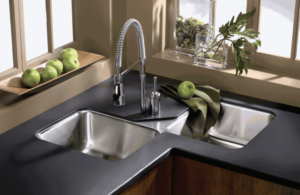Kitchen Sink
Sinks are a category of plumbing fixtures that includes kitchen sinks, service sinks, bar sinks, mop sinks and wash sinks. A sink is considered a different item than a lavatory (or a bathroom sink), although the terms are often used interchangeably. Sinks can be made of enameled cast-iron, vitreous china, stainless steel, porcelain-enameled formed steel, non-vitreous ceramic, and plastic materials.
Sink waste outlets should have a minimum diameter of 1-1/2 inches. Most kitchen sinks have an opening of 3-1/2 inches in diameter. A food-waste grinder has a standard opening of 3-1/2 inches, and so do most kitchen sink basket strainers. A strainer or crossbar should be provided to restrict the clear opening of the waste outlet.
Plumbing Requirements for Garbage Disposals
Food-waste grinders (also known as garbage disposals and disposers) are designed to grind foods, including bones, into small-sized bits that can flow through the drain line. Using them to dispose of fibrous and stringy foods, such as corn husks, celery, banana skins and onions, is not recommended because fibers tend to pass by the grinder teeth, move into the drain pipe, and cause drains to clog.
Water must be supplied to the grinder to assist during its operation in transporting waste. The water flushes the grinder chamber and carries the waste down the drainpipe. Blockage may result if the grinder is used without running the water during operation. Grinders should be connected to a drain of not less than 1-1/2 inches in diameter. Food-waste grinders are supplied with water from the sink faucet. They do not add to the load used to compute drainage pipe sizing. The drain size required for a grinder is consistent with that for a kitchen sink.
Plumbing Requirements for Dishwashers
The water supply to a residential dishwasher should be protected against backflow by an air gap or backflow preventer. The machine must be equipped with an integral backflow mechanism, or the potable water supply must have either a backflow preventer or an air gap. The discharge pipe from the dishwasher should be increased to a minimum of 3/4-inch in diameter. It should be connected with a wye fitting to the sink tailpiece. Before connecting to the sink tailpiece, the dishwasher waste line should rise and be securely fastened to the underside of the counter. The combined discharge from a sink, dishwasher, and waste grinder is allowed to discharge through a single 1-1/2-inch trap.
Maintenance Tips
Homeowners should take care not to overload the garbage disposal or the dishwasher, as this can lead to leaks and backups in the sink and the plumbing system. A backup at the kitchen sink may mean that the garbage disposal is clogged, or the plumbing line has some obstruction that prevents proper drainage. It’s important that homeowners understand the cause of the problem, as well as the proper way to repair it, before dismantling pipes under the sink. The right size of fittings and replacement parts, as well as proper drainage (including slope and traps) will ensure that the sink will work as it should following a repair, which is why most maintenance issues are best left to professionals, unless the homeowner has the proper instruction, parts and tools available.
Home Run Inspections, LLC
Oklahoma: 405-905-9175
We Cover All the Bases!
Serving: Oklahoma City, Edmond, Yukon, Piedmont, Bethany, El Reno, Tuttle, Mustang, Moore, Norman, Purcell, Midwest City, Del City, Choctaw, McCloud, Shawnee, Harrah, Newalla, Jones, and more.
Schedule Your Inspections Online at:
Like us on FaceBook
Follow us on Twitter
Follow us on Instagram



